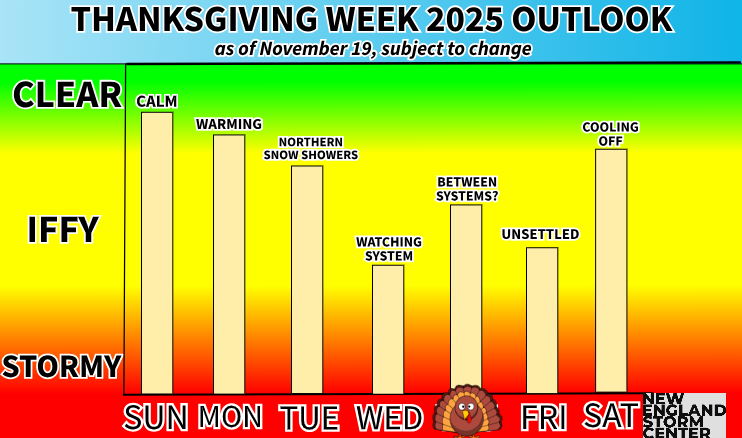Showers, Thunderstorms Enter the Picture for New England
- Tim Dennis
- May 16
- 4 min read
Today will see a tick up in temperatures for many as an increasingly strong and moist southerly flow develops ahead of a system approaching from our west. There will be much less of an onshore component. Humidity will continue to tick up, likely reaching the highest levels of this young warm season today and tomorrow.
Some sun and building humidity today will allow instability to increase in the afternoon. A weak warm front will pass into New England, generating the lift and forcing needed for scattered to widespread showers and thunderstorms in the late afternoon and evening. These will push west to east through the second half of the day.

Showers and thunderstorms this afternoon and evening will be most likely across western New England as well as into northern New Hampshire and Maine. Trends have been toward a later start time for storms to begin bubbling. The highest coverage will likely be in the evening and into the first part of the night. The closer you get to the coastal plain, the lower the chance of seeing a shower/storm gets. With rather weak forcing, there's some disagreement on just how widespread coverage will be today.
Below: Potential weather this evening (1st image) and overnight tonight (2nd image):
These showers and storms will likely be slower-moving, so extended downpours are possible. The Weather Prediction Center currently has much of northern Maine in the "slight" category (level 2 of 4) for excessive rainfall. Activity will likely begin to wane as the night goes on. Severe thunderstorms aren't really expected today, but there's always a risk that a couple could go rogue and become stronger.
The weekend will be heavily influenced by a frontal system passing through the region. This system will try to lift its warm front into the region during the day Saturday. This will place at least southern New England within the system's warm sector. A triple-point low (which is an area of low pressure that forms where a cold, warm and occluded front meet) will likely cross New England, paving the way for thunderstorm development.

Timing out Saturday's thunderstorms is very tricky and trying to pinpoint exact times at this point is a fool's errand. There may be two main rounds of storms, one in the morning and one in the afternoon and evening. Some activity will try to get going in the morning, though this is highly uncertain on exactly when and how widespread coverage will be. Scattered storms will then pop-up across the region throughout the afternoon and evening.
Below: Potential weather around mid-morning Saturday (1st image) and Saturday afternoon (2nd image):
One of the bigger uncertainties will revolve around how morning activity affects afternoon/evening activity. The timing and coverage of what occurs in the morning will have an impact on what can develop in the main event in the afternoon. Should the morning activity occur later in the morning and have decent coverage of storms, afternoon activity would likely be more limited, or widely scattered rather than widespread. Also, if clouds linger all day long, not as much instability will build for the afternoon, also limiting activity.
With a warm front and triple-point low crossing New England, there will be the possibility of some strong to severe storms. Looking at the main ingredients for severe storms, the approaching front and triple-point low will provide the lift needed for storms. Continued humidity will be in place for storms to feed on as well. Instability is a major question mark as it will hinge on how much breaks in the clouds can be achieved. CAPE values may build to over 1,000 joules/kilogram, especially in western New England, indicating an unstable atmosphere. This article thoroughly explains CAPE values and what it means.
Below: HRRR showing potential CAPE values Saturday afternoon:

The weak link for strong to severe storms will be shear. Shear values are looking to be on the lower end and will be the main limiting factor for the development of stronger storms. Overall, a severe weather outbreak is not expected. At this point, severe storms are more likely to be isolated in nature with more storms remaining below severe limits. The farther west you go in New England, the higher the severe chance will be. How this system evolves today across the Great Lakes will affect how it impacts New England, so the severe threat could increase or decrease over the next 24 hours. Trends will be watched.

The frontal system's cold front will cross New England Saturday night into Sunday, bringing a cooler air mass. It will also be far less humid. With that said, temperatures across coastal New England will likely end up around Saturday's levels or even a touch warmer as the front will switch the wind direction from an onshore influence (easterly) to an offshore one (westerly). In the spring, temperatures often hinge greatly on which way the wind blows. With a chilly ocean, subtle changes in wind direction can have an oversized impact on where temperatures end up.
For those looking for the start of summer weather, next week is a lost cause, plain and simple. This upcoming week has been shown to be persistently chilly for a little while now. We first brought up this cool-down in our "weather this week" article this past Monday. Widespread highs in the 50s and 60s will be likely throughout next week with little to no indications of anything warmer at any point.












Comments